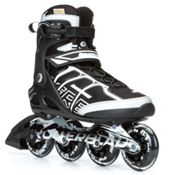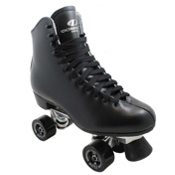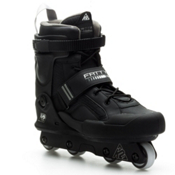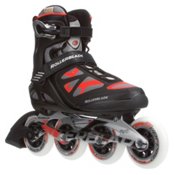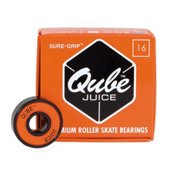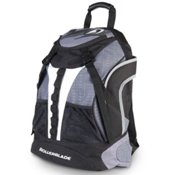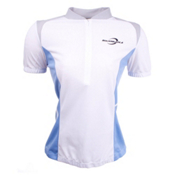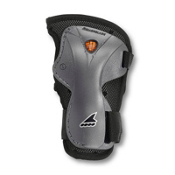History of Roller Skating
When you consider the history of roller skating you must first trace back the origin of the first pair of roller skates. The first known roller skate was invented in London, England by a Belgium born man named Joseph Merlin. Merlinís roller skate was not a quad skate, but rather an inline skate with small metal wheels. Consequently, Joseph Merlin was also an accomplished violinist and violin maker. In 1760, as the story goes, Joseph Merlin was invited to perform for an audience at a masquerade party at the prestigious Carlisle House Mansion in Sofo Square, London. Merlinís intent was to impress the crowd by playing his violin while skating on his newly invented roller skates. The festivities were progressing quiet well until Joseph Merlin accidentally skated into an expensive mirror, breaking the mirror and his violin, and injuring himself. Needless to say Joseph Merlinís performance did not successfully generate an enormous amount of interest in roller skating!
In 1819, nearly 60 years later, a Frenchman named Monsieur Petitbled invented, and officially patented his new roller skate design. Monsieur Petitbledís roller skates were also in-line skates with three wheels made of wood, metal or deluxe ivory. Petitbled tried to sell the public the idea that a person could do anything on his roller skates that could be done on a pair of ice skates. Unfortunately for Monsieur Petitbled he was unable to convince a skeptical public, and his roller skates did not fair well on the market.
The next roller skate patent came in 1823 by an Englishman named John Tyers. John Tyersí patented roller skate was known as the Volito. Tyersí Volito roller skates consisted of five wheels in a line with the center wheel larger than the two wheels on either side. His roller skate design obviously required the skater to tilt the foot forwards or backwards to grip the surface for pushing off. Tylerís Volito was also unique in that his design introduced the first roller skate brake. His roller skateís brakes consisted of a metal toe stop in the front, and a metal stop in the heel; this allowed the skater to stop by leaning sharply in either direction. Unfortunately for John Tyers, and the sport of roller skating, his roller skates did not create a world-wide appreciation for roller skating. However, some of the expert ice skaters of the day proved that a skater could perform many of the same moves on his roller skates, that couldíve only been performed previously on a pair of ice skates.
By the 1860s the idea of roller skating had reached America, and in 1863 a young inventor named James Leonard Plimpton created a new, and superior type of roller skate. His roller skates allowed the skater to steer the skates in different directions. We would consider Plimpton an out of the box thinker as he moved away from the known ďin-lineĒ roller skates of his day. He built his skate with two wheels in the front and two in the back, much like the quad roller skates youíd find today. Plimptonís wheels were mounted on carriages that rotated when the skaterís foot leaned to one side or the other. This feature allowed for smoother turns, and significantly enhanced the skaterís capability to skate backwards. Lastly, Plimptonís roller skates provided the skater a superior glide when compared to the other roller skates of his time.
James Plimpton did far more to promote roller skating than designing an outstanding roller skate. Plimpton built a large roller skating rink in New York City, and Newport, Rhode Island. He also made it easier for anyone to roller skate by leasing his roller skates to his customers. Additionally, Plimpton developed an effective system for teaching group roller skating lessons, and provided incentives by creating proficiency medals. In 1863 he founded the nationís first roller skating association, the New York Roller Skating Association. He also hired Jackson Haines, a famous ballet dancer and excellent skater, to put on shows to help promote his roller skates and the sport as a whole. James Plimpton successfully changed the way people thought about roller skating, and is considered by some the founding father of modern day roller skating.
Over the years there were various improvements made to Plimptonís roller skate; from the use of ball bearings, to the first all metal skate. However, it wasnít until roller skates were mass produced near the end of the 1800s that the average working class person could afford them. During this period the price of a pair of roller skates dropped to half the price of Plimptonís hand-crafted roller skate. The mass production of roller skates was most certainly instrumental in ushering in a whole new market and generation of skaters.
Quite naturally this generation of skaters began looking for new things to do on their roller skates. Artistic roller skating experienced a surge in popularity as a spin-off (no pun intended) of figure skating sometime in the 1880-1890s. Roller hockey began to be played on roller skates using the rules for field hockey; roller hockey was called polo at this time. Speed skating also quickly increased in popularity, and drew large crowds in New York and other large cities in the US and Europe.
Roller skating in all forms continued to become more popular and expand as a recreational pastime in the early 1900s. However, roller skating suffered a decline during and following WWI. After the war more people began driving cars, going to movie theaters and turning to other forms of entertainment. Roller skating experienced a surge during the Great Depression because it was relatively inexpensive, and more accessible to the average person. In 1937 the Roller Skating Rink Operators Association was formed; today we know it as the Roller Skating Association.
Roller skating steadily grew in popularity over the next three decades then exploded in the 1970s. In the 1970s roller skating was no longer considered by many as a mere recreational pastime, but rather a very cool thing to do! It was during this time that roller skating and disco music teamed up to create a craze that captivated much of America. Thousands of roller skaters became involved in artistic, figure, dance, speed, roller derby, and freestyle roller skating. Various types of formal roller skating competitions were held, outdoor roller skating became very popular, and the public simply couldnít get enough! The 1970s was definitely the decade for roller skating.
During the 1980s the roller skating craze waned significantly, but experienced a boost in the mid 1990s when inline skates hit the market full force. Inline skates allowed a far smoother ride outdoors, and became an instant hit with many ice skaters. Ice hockey players, in large numbers, also began playing inline hockey during the off-season. Inline skates also became extremely popular with many people that enjoyed skating for fitness. The ability to inline skate outdoors, over long distances, became a dream come true for fitness skaters all over the world. Lastly, aggressive and jump skating increased in popularity in the 1990s, and created yet another type of skater with its own unique culture.
Roller skating has come a long way since its introduction to world in the 1700s, and continues to grow and expand with new types of roller skates and roller skating activities. Today it is not uncommon to find people from all walks of life, enjoying various indoor, outdoor, inline, and quad roller skating activities. Roller skating has truly became a pastime, hobby, or sport that people of all ages can enjoy.
|
Skate Equipment >
Roller Skating Equip
Roller Skating Info
_
